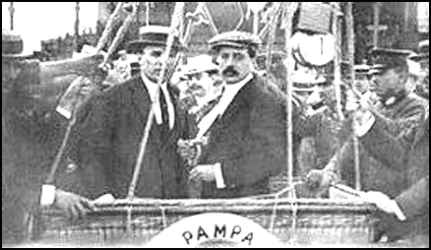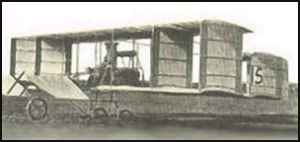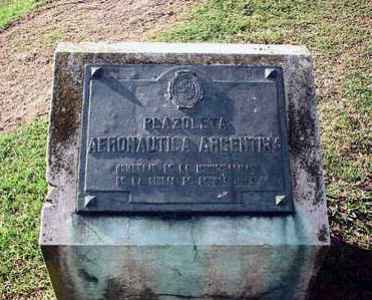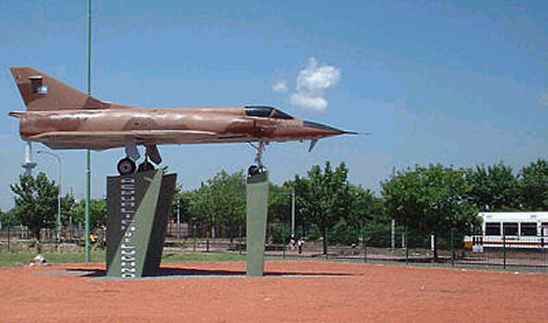
|
Porto Barrial y Commercial de la Zona Sur Historia del Barrio El primer aeródromo del país by Hernando Mankus |
|
The first aerodrome of the country by Hernando Mankus |
 |
|
Jorge Newbery and Aarón de Anchorena, moments before the
historical ascencion of the "PAMPERO", a lifering appeared hanging on the basket, which had belonged to the troopship "Pampa" of
our Navy. Gentileza: Juan Viegas |
|
It was on Christmas Day of 1907 that the "PAMPERO" rose from the Sociedad Sportiva Argentina,
located in the district of Palermo, to descend two hours later on the neighboring border with Uruguay. Jorge Newbery and Aaron de
Anchorena were the first Argentineans to make an ascent in their mother country. The success achieved by the "PAMPERO" caused great enthusiasm among the young people. So it was that on the 13th of January of 1908, the Aero Club Argentino was created, the pioneering organization of our wings, of which Aarón de Anchorena was the first president The airship practice in that only balloon began that told to the brand new Aero Club. And on the afternoon of the 17th of October of 1908, the "PAMPERO" rose for the last time from the village "Los Ombúes" of the district of Belgrano carrying in its basket the young dentist Eduardo Newbery and his occasional companion. staff sergeant Eduardo Romero, who was going to make a night raid. They never returned and nothing more was ever known known of the "PAMPERO" and its crew. That tragedy almost caused the dissolution of the Aero Club Argentino, but with the passage of time, the pain was mitigated. At years end of 1909, our country was in full preparation to celebrate the Centenario de la Revolución de Mayo. One of the commissions created to manage the Olympic Games, was headed by President Baron Antonio de Marchi, son in law of General Roca and promoter of the sport. Founder of the Sociedad Sportiva Argentina, a model institution model of the kind and a member of the Commission of the Aero Argentine Club, considered that he could not fail between the described spectacles to be carried out during the festividades, the one of flight to motor. By means of official support and his own personal efforts, he arranged for a competition between two outstanding European aviators. With the sponsorship of the magazine "L'auto" of Paris, he obtained the service of the French aviator Henry Breguí, who arrived in Buenos Aires on the 8th of January, 1910, bringing with him two Voisin airplanes equipped with motors of 50 and 60 horses respectively. One week later, on the 16th of that month, responding to an invitation of the Baron of Marchi, the Italian pilot Ricardo Ponzelli, brought an airplane similar to the one of Breguí. Ponzelli established himself in the Hipódromo de Hurlingham and Breguí in the one of Longchamps. |
 |
|
On January 30, Ponzelli transferred his Voisin to the Firing range of the Campo de Mayo for his initial
flight. He made a successful takeoff and gained ten meters of altitude, but when he had traveled some hundred meters down the line,
the wind caused the biplane to become unstable and he made a violent landing, causing the breakage of the tail and undercarriage.
However Breguí on February 6, at 5:35 PM, before an estimated crowd of three thousand people , he took off and made two turns
around the track. At 6:45 PM, his second flight of the day was made successfully. It was by these two outstanding pilots that the first demonstrations of mechanical flight were made in our country and in South America. In 1910, the Comisión de Festejos del Centenario,, asked the Aeroclub Argentino to organize an aviation festival, which would require the establishment of an airport. The chosen location was on the property of the Fiorito Brothers, in the lower Lugano, in the Valle del Riachuelo.. There were no streets in the area, Larrazábal was only one track, Tellier (today Lisandro de la Torre) was the division between two country houses, parallel to the Riachuelo existed a dirt road that united Puente Alsina with Puente de la Noria, today the Avenida Coronel Roca. Since 1901 there had existed a steam street car line that ran between Rivadavia and Lacarra and the new slaughter house, and also happened to pass through Lugano. In 1903, Ricardo Seeber it installed another one, which ran between the Riachuelo and the slaughter house, and both merged in 1906. The limits of the airfield, based on an aerial photograph taken in December of 1936, can be established between Chilavert, Murguiondo, Madariaga y Lisandro de la Torre streets. Currently the area is occupied by the buildings of the Barrio General Savio (Lugano I y II). The field had a perimeter of approximately 2 000 meters and included eight wooden sheds and panels which served as hangars, lodging for the personnel, a factory, grandstands two blocks long for the spectators, water provided by means of a mill and a pump, regulation signposts and a perfectly leveled landing strip. |
 |
|
The airport was officialy dedicated the 23rd of March of 1910 with the flight of Emilio Eugene
Aubrún, who initiated the name, "Fortnight of Aviation". The public was excited by the flights and dazzled by the Voisin, Farman and
Bleriots, airplanes that reached the fantastic speed of 60 kilometers per hour. But before its inauguration, on the 5th of March of 1910, Aubrún made the first takeoff from the airport in his Blériot X. Later, on the 11th of March, makes Henry Piquet (the first aviator to transport mail in the world) took control of a Voisin. Considering that to arrive at the Airfield was a long trip and to avoid useless trips, a system of flags was placed in Plaza Once y Plaza Flores: the red flags meant "There are flights in Lugano", the white flags meant "Perhaps" and the blue ones meant "There are no flights".. Emilio Aubrún instructed Jorge Newbery and Carlos Goffre, Henry Breguí Juan Carlos Roth and Florencio Parravicini, outstanding actor. On the other hand, Alfred Valletón instructed his contryman Francisco Herman Hentsch. The students received their licenses in June of that year. Fels, Eusebione and Amalia Figueredo also learned to fly there.. It was Aubrún who made the first night flight in the country: he took of in his machine from the aerodrome of Lugano on the 13th of March of 1910, at 9PM, landed about two kilometers away at the Tapiales station, remained there until 11PM, returning to Lugano without stopping. In order to visualize the landing strip, containers of kerosene were placed, two at the beginning and one at the end.. In addition it should be noted that in the existing factories in the airport , the French constructor Paul Castaibert built the first airplanes using exclusively national materials. They were also sold in other countries which demonstrated that the Luganense industry extended well beyond the borders of Argentina. For this reason, the Aviation school of the Eastern Republic of Uruguay decided to use these airships at the time of its foundation. |
 |
|
The "Lugano" airport remained active until 1934, when the journalist Juan Jose De Soiza Reilly, in an
article published in the magazine Caras y Caretas of the 10th of January of 1931, baptized it "The Nest of Condors" in Buenos Airean
Pampas. Today the first aerodrome of the country is remembered and honored by a small square located at the intersection of the Avenue Francisco Fernandez de la Cruz and Larrazábal, whose name is "Aeronáutica Argentina". Until recently there was only a small monolith (in serious need of conservation) with a memorial plaque. |
 |
constituted the only tribute to the first aerodrome of the country. |
| But during the months of October and November of the 2001, the small square was remodeled, surrounded with railings, and on the 30th of November, there was mounted a Mirage III C, registration number 706, donated by the Argentina Air Force to the Civil Association "Republic of Lugano" and to the City of Buenos Aires. This represented the pride which was felt for the district that was the cradle of the Argentine aeronautics. |
 |
|
Consulted sources: - - Fuerza Aérea Argentina: "Reseña Histórica - Años 1907 a 1910" (www.faa.mil.ar) - Revista "Aeroespacio" Nº 540, edición Mar/Abr del 2001 (www.aeroespacio.com.ar) |


|